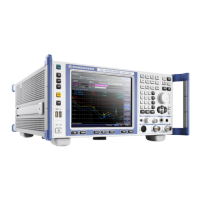Spectrum Measurements
R&S
®
ESR
308User Manual 1175.7068.02 ─ 12
●
The table contains the number of samples used in the calculation and, for each
trace, the following values:
– Average amplitude
– Peak amplitude
– Crest factor
● CISPR specifications vs R&S ESR specifications.................................................308
● Examples of CISPR APD......................................................................................308
● Softkeys for CISPR APD Measurements.............................................................. 311
CISPR specifications vs R&S ESR specifications
The following table compares the characteristics of the R&S ESR against the CISPR
specifications for APD measurements.
CISPR 16-1-1 R&S ESR
Dynamic range of the amplitude > 60 dB > 75 dB
Amplitude accuracy better than ±2.7 dB < 0.2 dB (typical)
Maximum measurement time ≥ 2 min 2 min (no dead time)
Minimum measurable probability
10
-7
10
-7
Amplitude level assignment min. 2 amplitude levels with a res-
olution of 0.25 dB or better
691 levels with a resolution of
0.145 dB
Sampling rate ≥10 MSamples
(using an RBW of 1 MHz)
16 MSamples (with RBW = 1
MHz)
4.0 MSamples (with RBW = 120
kHz)
0.26 MSamples (with RBW = 9
kHz
5.8 kSamples (with RBW = 200
Hz)
Display resolution of APD mea-
surement data
< 0.25 dB Default: 0.145 dB for range = 100
dB
Min. 0.00145 dB for range = 1 dB
●
Use the intermittent measurement if the dead time is < 1 % of the total measure-
ment time.
●
Measure the probabilities corresponding to all pre-assigned levels simultaneously.
●
The R&S ESR records the probability of time for each of the 625 disturbance lev-
els.
Examples of CISPR APD
APD of the inherent noise of the R&S ESR
The following example shows the APD of the inherent noise of the R&S ESR (input ter-
minated by 50 Ω.
Measurements

